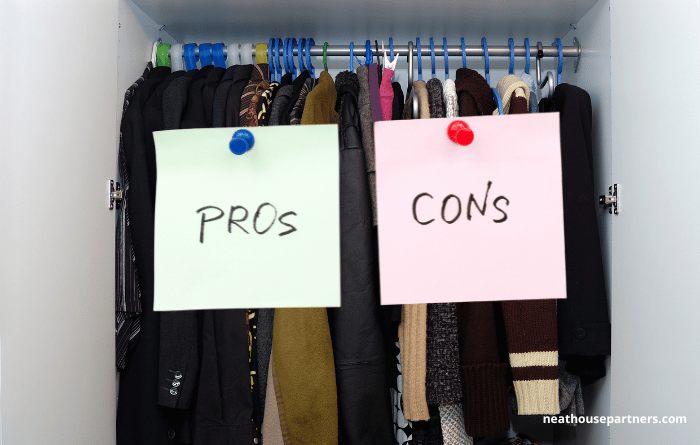During the COVID-19 pandemic, the workplace looked very different for many people.
A large proportion of workers were required to work from home where possible leaving skeleton staffing in professional buildings around the country.
As a result, workplace dress codes became far less of a focus over finding ways to get the work that needed doing, done, in challenging circumstances.
Now that things are back to normal, or businesses have found a new normal for the way that they work as a result of the lessons learned during the 2020-2021 lockdowns, it’s fair to wonder if formalities like dress codes are still necessary.
Is a workplace dress code still a necessity post-covid?
Read on as we explore the pros and cons of workplace dress codes in a post-COVID world and the questions that you might need to ask to set the way forward when it comes to the standards of dress code in your organisation.
For the purpose of this article, we’re focusing on organisations that set their own dress code requirements, not those that are required to wear specific clothing for Health and Safety or professional standards, such as the Police, Hospital staff and Construction workers.
Workplace Dress Code Pre-Covid Vs Now
Power suits, ties, formal shoes and corporate uniforms would have been commonplace and expected work attire in most offices around the country pre-covid. Any deviance from this would likely have attracted calls of unprofessionalism from colleagues unless working in typically more relaxed industries like creative agencies, but after nearly 18 months of getting the same work done in much more casual wear at home, is now the time to throw formal dress codes firmly out of the window?
Whilst it’s unlikely that flip flops, PJs or yoga bottoms will ever be considered suitable for a professional workplace environment, there is a conversation to be had to agree on what the right approach to dress code in your organisation is.
Pros And Cons Of Dress Codes
In a workplace setting, more formal attire can be seen as a sign of respect for colleagues and clients, as well as representing the professional brand of the company.
On the other hand, more relaxed attire can be seen as a sign of trust and openness, two qualities that are important in developing positive working relationships.
It can also be seen as a way to promote creativity and individuality, two things that are important in many industries.
As there will always be advantages and disadvantages to having, or not having a workplace dress code, here are some points to consider when thinking about the way forward for your organisation.
Pros
- Dress codes can help to promote a professional image for your business. In industries where first impressions are important, such as the legal or financial sectors, it’s essential to maintain a look that instils confidence in potential clients.
- Dress codes can also boost employee productivity. Studies have shown that employees who dress in more formal attire are more likely to feel professional and take their work more seriously.
- In a post-COVID world, dress codes can also help to promote a sense of unity and togetherness amongst employees. After such a long period of working remotely, it might be difficult for employees to adjust to being back in the office. Wearing more formal attire could help to make the transition easier.
Cons
- Dress codes can be restrictive and stifle creativity. In industries where creativity is important, such as the advertising or fashion industries, it’s essential to allow employees to express themselves.
- Dress codes can also be seen as outdated. In a world where more and more businesses are embracing casual dress codes, it can be difficult to stand out from the crowd if you’re still maintaining a more formal look.
- Dress codes can also be costly for employees. If employees are required to buy new clothes to comply with the dress code, this can be an additional expense that they might not be able to afford.
- Dress codes can be seen as a way of micromanaging employees. If employees feel like they are being told how to dress, this can lead to feelings of resentment and frustration.
Considerations For Dress Codes In A Post-Covid World
If you’re thinking about maintaining a workplace dress code in a post-COVID world, there are a few things that you need to take into account before setting or amending your policy at your place of work.
- Consider how your employees feel about returning to a dress code after such a long period of time working in more relaxed attire, and also think about the message that you want to send to your customers and clients. Are you trying to convey a message of professionalism and authority, or are you more concerned with promoting a creative and relaxed environment?
- Will your dress code apply to all employees regardless of where they are working? If so, what are your expectations and how will this be monitored? Fully remote working and hybrid working are far more commonplace post Covid so it’s important to think about how any new or updated policies on workplace dress code impacts all of your staff, not just those in the office.
- It’s also worth considering the practicalities of returning to a dress code. For example, will employees need to buy new clothes to comply with the dress code? If so, is there anything that you can do to help them with this cost?
- When thinking about workplace dress codes, it’s important to consider the potential for discrimination. Employers need to be mindful of the fact that some dress codes could be seen as discriminatory against certain groups of people, such as religious groups or those with disabilities. When creating or updating a dress code, employers should consult with employees to get their feedback and input on the policy. This will help to ensure that the policy is fair and inclusive for all.
Whilst dress codes can be a controversial topic that attracts plenty of differing opinions, ultimately, there is no right or wrong answer when it comes to workplace dress codes in a post-COVID world.
It’s important, however, to weigh up the pros and cons and make a decision that is both fair to all of your employees and right for the image your organisation wants to project and the work that it does.
Next Steps
Do you think workplace dress codes are still necessary in a post-COVID world?
Let us know what you think. Please contact us if you would like any support managing uniform policy creation and maintenance in the workplace, need assistance managing difficult conversations around this topic, or ensuring that you don’t fall foul of discrimination laws with any dress codes that are implemented.







